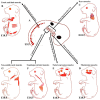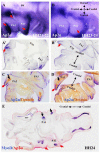New Insights into the Diversity of Branchiomeric Muscle Development: Genetic Programs and Differentiation
- PMID: 36009872
- PMCID: PMC9404950
- DOI: 10.3390/biology11081245
New Insights into the Diversity of Branchiomeric Muscle Development: Genetic Programs and Differentiation
Abstract
Branchiomeric skeletal muscles are a subset of head muscles originating from skeletal muscle progenitor cells in the mesodermal core of pharyngeal arches. These muscles are involved in facial expression, mastication, and function of the larynx and pharynx. Branchiomeric muscles have been the focus of many studies over the years due to their distinct developmental programs and common origin with the heart muscle. A prerequisite for investigating these muscles' properties and therapeutic potential is understanding their genetic program and differentiation. In contrast to our understanding of how branchiomeric muscles are formed, less is known about their differentiation. This review focuses on the differentiation of branchiomeric muscles in mouse embryos. Furthermore, the relationship between branchiomeric muscle progenitor and neural crest cells in the pharyngeal arches of chicken embryos is also discussed. Additionally, we summarize recent studies into the genetic networks that distinguish between first arch-derived muscles and other pharyngeal arch muscles.
Keywords: branchiomeric muscles; differentiation; mouse embryo; neural crest cells.
Conflict of interest statement
The authors declare that the research was conducted in the absence of any commercial or financial relationships that could be construed as a potential conflict of interest.
Figures





Similar articles
-
The Emergence of Embryonic Myosin Heavy Chain during Branchiomeric Muscle Development.Life (Basel). 2022 May 25;12(6):785. doi: 10.3390/life12060785. Life (Basel). 2022. PMID: 35743816 Free PMC article.
-
The del22q11.2 candidate gene Tbx1 regulates branchiomeric myogenesis.Hum Mol Genet. 2004 Nov 15;13(22):2829-40. doi: 10.1093/hmg/ddh304. Epub 2004 Sep 22. Hum Mol Genet. 2004. PMID: 15385444
-
Relationship between neural crest cells and cranial mesoderm during head muscle development.PLoS One. 2009;4(2):e4381. doi: 10.1371/journal.pone.0004381. Epub 2009 Feb 9. PLoS One. 2009. PMID: 19198652 Free PMC article.
-
Core issues in craniofacial myogenesis.Exp Cell Res. 2010 Nov 1;316(18):3034-41. doi: 10.1016/j.yexcr.2010.04.029. Epub 2010 May 8. Exp Cell Res. 2010. PMID: 20457151 Review.
-
Emergence of heart and branchiomeric muscles in cardiopharyngeal mesoderm.Exp Cell Res. 2022 Jan 1;410(1):112931. doi: 10.1016/j.yexcr.2021.112931. Epub 2021 Nov 16. Exp Cell Res. 2022. PMID: 34798131 Review.
Cited by
-
Pharyngeal airway dimensions and adipose distribution in the minipig.J Oral Biol Craniofac Res. 2025 Jan-Feb;15(1):77-83. doi: 10.1016/j.jobcr.2024.12.004. Epub 2024 Dec 15. J Oral Biol Craniofac Res. 2025. PMID: 39790991 Free PMC article.
-
Nkx2.7 is a conserved regulator of craniofacial development.Nat Commun. 2025 Apr 23;16(1):3802. doi: 10.1038/s41467-025-58821-3. Nat Commun. 2025. PMID: 40268889 Free PMC article.
-
Integrated analysis of miRNAs-mRNAs in skeletal muscle development revealed that novel-miR-766 affects myoblast differentiation and myofiber-type formation in sheep.Front Cell Dev Biol. 2025 Jul 31;13:1615676. doi: 10.3389/fcell.2025.1615676. eCollection 2025. Front Cell Dev Biol. 2025. PMID: 40823533 Free PMC article.
References
Publication types
LinkOut - more resources
Full Text Sources

